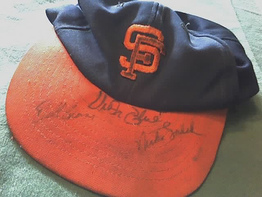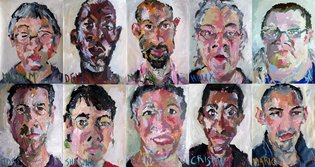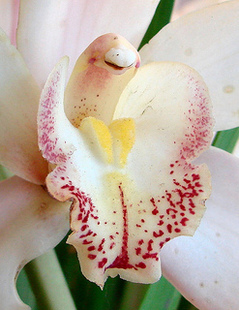 baseball cap / starlord The outcome is clear. Tigers swept in four games. Giants victorious. And though nobody asked me, I am certain I saw the gods intervene in game one of the World Series when the redoubtable Justin Verlander, beloved of pundits and Detroit fans, whose pitching was the best, so everyone said, faced Your San Francisco Giants. Their game was once described by pundits as “torture” because fans suffered so. You may not see it, but I see a parallel with the Trojan War. Thus did the goddess Athena disguise herself to lure Hector out of Troy to do battle with Achilles, who causes Hector’s inevitable death. And likewise, the gods tease the Tigers into thinking they can prevail, that it's a level playing field. And then the gods, for their own entertainment, begin siding, sliding and abiding with our home team. How else account for a ball hitting third base to the bafflement of the Tigers, whose minds seemed momentarily clouded. How else does Pablo “Panda” Sandoval smack the ball over the wall three times against a pitcher who sneers when his coach comes out to the pitcher’s mound to check on him? He’s that good so it’s an insult. Only the gods could make a clutch hitter out of Barry Zito, the pitcher. Pitchers don’t have to hit the ball. Everyone knows that. I stopped watching that first game before the final score was 8-3 because I had decided to go to a dharma talk and intended to walk to the Zen Center on Laguna at Page. Again along the way I saw the gods at play; how else explain camaraderie instead of the usual dark night wariness? Down Gough and up Hayes, people laughed and chatted good-naturedly. I doubt anyone would ask a stranger, “Hey, why are you talking to me? Do I know you?” Being filled with and surrounded by good will and aware that the gods have intervened, I feel as if I carry close to my heart a miraculous ball of light, and I want to show it to anyone willing to share it. When a man pushing a shopping cart passes, I dazzle him thusly: “We are winning six to nothing and Pablo Sandoval hit three home runs.” I can see he is happy at the good news. We exchange smiles, and I continue along Laguna. At the Zen Center, as one might expect, it’s mostly silent. I don’t see anyone checking a mobile device. I have left mine at home. Adding my red leather sandals to the shoes outside the door of the room where Rev. Keiryu Lien Shutt will give the dharma talk, I settle on a padded bench along the side of the room. Once Reverend Shutt performs the rituals that precede a dharma talk, and adjusts the hem of her robe to cover her feet, and thanks her teacher and the one who invited her to speak, she asks us the score of Game One. Baseball is not a religion and the Greek gods long ago emptied their closets on Mount Olympus and no longer visit woods, groves or kitchens, but some gods seem to hover over the SF Giants. They cause community wherever folks pass each other or gather – at the opera, in bars, restaurants, on dimly lit sidewalks or on BART where fans periodically yell out the score. One such community of Giant fans settled in Section 140 at the ballpark is like a family, and reporter Mike Kepka writes of them in the Oct. 28 San Francisco Chronicle in an article called “Love in left field.” He writes, “In this story the regulars in Section 140 are the Giants. They represent everything that is great about baseball and a city that loves its team.” Following the Giants’ sweep of the Tigers in ten innings at rainy, cold Comerica Park in Detroit, Giant General Manager Bruce Bochy praised the team for playing unselfishly. It was a collective win!! Nobody asked but I believe the gods are smirking as they stroll among the thousands and thousands of fans celebrating in Civic Center and throughout the city. And there’s an occasional very high five.
 Photo from wall at EBMC / Facebook As often as a class opens at the East Bay Meditation Center and I can arrange to be in Oakland, I go. From Civic Center BART to 19th Street and up Broadway toward Grand takes about 25 minutes, less time if I hop the Richmond or the Pittsburgh Bay Point just as it or I arrive.* I try to go early to help set up the rows of folding chairs and lay the zafu and the zabutons, the cushions and the mats. If it is useful, I am a greeter, someone who checks off names, hands out material or suggests nametags, whatever the teacher asks for. If it is convenient for Mahogany, the event planner, she will take over just before the class begins. Once in awhile I register for a class and am wait listed. Ego might ask what is this about? I am a monthly donor, I practice dana, or “Generosity”; I help; I care, I…I…I. But I knows this is EBMC practicing its commitment to inclusivity and diversity. I can attend any function once that commitment has been met. “About EBMC” on their website tells me programs are for the widest possible audience. For example, some programs are specifically for People of Color, or the Lesbian, Gay, Bisexual, Transgender, Queer, Questioning, Intersex & Same-Gender Loving Communities. “This provides a safe space for individuals who daily confront the effects of oppression, racism, or homophobia and heterosexism in their lives, and who therefore may choose to initially avoid mixed programs.” I like being in a space that consciously chooses to be inclusive and diverse. The desire to be more than an onlooker in such a community could be rooted in my teaching years in the Los Angeles Unified School District at Alain Leroy Locke High School, an inner-city school built in response to the Watts Riots. I was a white teacher in a black community. One memory, in particular, continues to reconnect me to oppression and racism. I taught sports writing, so I often went with students to athletic events at other high schools. The Locke High Saints had an all-black basketball team and when it traveled to suburban parts of Los Angeles, I would take student reporters to cover games. On the way to Westchester High School, we passed a Locke Saint pulled over by the police, his body pressed against the side of his car. I recognized him as one of my students and yet I drove by, not stopping to intervene in what appeared to be harassment based on color. This happened in mid-1970. I have not forgotten. Teaching at Locke loosened any certainties I had. I learned lessons I might not have learned; the first one – to laugh at myself. The second, there is no “Black Student” there are only young men and women who call themselves by their first names with “dog” added. “Phill-dog” and “Trav-dog,” and out of respect, because I was the teacher, I was Ritt-dog. At East Bay Meditation Center, I am not the teacher with built in power; we are all equal. Our teachers are frequently people of color. I sit among learners, many of whom are much younger, but always we are an inclusive and diverse group. I am not at EBMC so I can “feel good” about my “goodness” or to make reparation for an act of cowardice. I want my Buddhist practice to include the fact that I am white, educated and economically advantaged. I don’t want meditation to be me closing my eyes to the ramifications of race and gender. I want to examine the cultural formulations that influence my responses – anything that keeps me from being present and responsive to others who have historically been represented as “less than” because history in schools was written by educated, middle and upper class European and European American men to justify the dominance of middle and upper class European and European American men. This is the worldview I was taught, but I want a better vision. Larry Yang writes about training to undo oppressing and being oppressed -- we have all been the perpetrator and the victim -- as “the journey towards narrowing the experience of separation.” Following these principles in his training, I commit to searching out ways to diversify my relationships and to increase my sensitivity towards people of different cultures, ethnicities, sexual orientations, ages, physical abilities, genders, and economic means. I commit to examining with wisdom and clear comprehension the ways that I have privilege in order to determine skillful ways of using privilege for the benefit of all beings. I commit to the practice of generosity in all aspects of my life and towards all human beings, regardless of cultural, ethnic, racial, sexual, age, physical or economic differences. ** Mine is that path of inclusivity and diversity each time I register to attend a class or meditate at EBMC as well as each time I am wait listed. * EBMC is moving to 285 17th Street near Harrison and three blocks from the 19th Street BART Station.
**On the website www.eastbaymeditation.org is a PDF document by Larry Yang, Directing the Mind Toward Practices in Diversity
 Whole Wheat a la Tassajara / Editor B On Wednesday I experienced a “shifting-into-place,” an awareness that I was quite fine as I was despite being no different than I had been before coming to this conclusion. Buddhist teacher Tara Brach wrote about “shifting-into-place,” in a blog when she described Zen teacher Ed Brown’s realization in his early years at Tassajara Zen Mountain Center that his biscuits were fine just as he was baking them. For years, he had been discouraged because, to him, those biscuits didn’t taste like the Pillsbury biscuits he’d “made” many years ago. I think of all the years I have coped with the belief that I was not-good-enough, not in regard to biscuits because I don’t bake, but in regard to my essential self. On Wednesday, despite having the same history, scars, propensity for pettiness, and limitations, I suddenly didn’t see myself as a problem in need of fixing. This shift doesn’t alter my intention to continue my weekly time with therapist, Jennifer. Neither do I plan to stop sitting meditation or to cease classes at the East Bay Meditation Center. And I will continue sharing not always attractive personal truths, although the motivation may no longer be to compensate for “not being enough.” I still want to be heard and more than ever I want to hear others tell their truths. On Wednesday, I accepted just this: being as I am. At that moment, I felt myself at rest in reality. I was just as I was without further judgment of who or how I should be. From this shifted perspective, I now want my efforts to seek inner peace to be in service of all beings, to cause no harm. We are, after all, interconnected. Are we not? I can’t say exactly why on Wednesday something shifted. Perhaps it was tied to the four-week course on Buddhist precepts that ended the night before. I had been profoundly moved by learning what it would be like to live the precepts day-to-day, how tightly tied was my behavior to the well-being of all the people with whom I would come in contact and whom they would someday meet. Yet appreciating the precepts didn’t happen the first day I saw them written on flip chart paper and taped up at the East Bay Meditation Center. The teacher, Mushim Ikeda, had drawn a line down the center of the paper and introduced “Five Precepts in Simple Form” from the dual perspective of what one is not to do on the left side and what living them entails on the right side. 1. Not to kill but to cherish all life. 2. Not to lie but to tell the truth. 3. Not to steal but to respect the things of others. 4. Not to commit sexual misconduct but to respect the wholeness of relationship. 5. Not to misuse or deal in intoxicants but to practice clarity of mind. Sort of do’s and don’ts if one were to see them as prescriptive like the Ten Commandments. But that is not, Mushim told us, the Buddhist way to work with precepts. I have to admit at first glance I was dismissive. Four weeks studying these? I thought what a waste of time. I was wrong to underestimate the value of thinking about how to live. Consider the first precept: Cherish Life. This precept means cherishing one’s own, not just the life of a water buffalo or a dairy cow, a stray spider on the shower curtain or the ant infestation on a hot day. How do I actually live by this precept day after day? I thought of a time in the recent past when I did not cherish my life enough to tell someone clearly and simply, “This is not working for me.” That failure to speak up for myself resulted in hurt feelings and rancor I know did not add to the good of all beings. Buddhist teacher Diane Eshin Rizzetto explores the precepts in her book Waking Up to What You Do. She reminds me that I will not suddenly rise to every occasion just by memorizing the precepts. Living with these aspirations needs an ongoing, active engagement with everyday choices. In the smallest moments I can apply the precepts by asking: “How do you choose to live your life?” Ultimately, I find the precepts to be so profound that I vow to begin again and again, not to be deterred by my failures to apply them skillfully. Perhaps with practice, I can use the precepts to cause no harm. And should I cause harm unwittingly, I can intend to do better next time.
 iPad / Pamela Graham I told Jill at the Apple store I would come back and buy an iPad after I took my car to the car wash. Perhaps she thought I would be back that afternoon or at least by the next day. That would be her miscalculation. She could not know the mild terror I felt at the prospect of being hooked to the chain and bumped through the automated carwash. Perhaps it was two weeks later that I found a carwash, gritted my teeth, got hooked to the chain, bumped through and came out of the suds and blow dryer shining. Yet I did not immediately purchase the iPad of my desire. I had promised my friend, Kate, I would first buy an external hard drive to back up my computer. A Sunday or so ago, my friend, Lindasusan, gave a sermon at First UU and because I was leading a spoken and silent meditation, I sat on the chancel and could see her sermon on her iPad! I fiddled with the paper on which I had written the poem I would recite; the value of an iPad increased tenfold. But not having an iPad has value too. I love wanting it. The more I don’t own it, the more I want it. Wanting directs my attention. Of course, before I actually commit, I must consider all the options: KindleFire HD, Google Nexus7, etc. There’s lots to like about all the options, including price. Even writing about wanting has become interesting. I want this iPad with the same passion I wanted a juice extractor, a large messy piece of machinery I imagined would make me healthy because of the carrots and kale I would be swilling. It sits unused. I wanted an espresso machine once, perhaps it was red. I remember my oldest son predicting I would not use it. He was right. I know it’s the desire for whatever I currently want that thrills me. Apparently, it’s easy to confuse the desire and the object at which it is directed. Hope for changing one’s life attaches to an object, but my domicile and my past are cluttered with cast-offs that lost their luster soon after being acquired. If you were to ask me, “What is the true nature of your desire?” I would say, “I want an iPad.” I have seen it explained that the compelling nature of wanting confuses the object with the underlying desire. But the want isn’t quite like that. Nicole Daedone on tricycle.com talks about wanting, whether it is a person or an object. “Rather than feeling the pure burn of desire, we get caught in what the Buddha called tanha, in craving the object of our desire, believing we must have it to be happy. Tanha translates roughly to ‘thirst.’ We think we are thirsting for an object…. But what we actually desire is intimacy—the hydration of direct experience saturating our cells…love is found in the animating quality of our attention.” That means so much to me because locking in on a desired object or experience makes me feel alive and purposeful. Each iPad, each object of my desire, fills me with so much enthusiasm, I don’t want to buy it for fear of ending the underlying feelings. Eventually I will buy something. I have heard that in November new choices will be available and having gone this long with only the desire, I am eager to wait a bit longer. I realize that with iPads as with other people, Nicole Daedone has it right: love is really the animating quality of my attention, and is not inherent in the other or the object. If I commit my attention to something or someone, I will not only experience love, I can become love, and the source of love can be seen as inside me. As for the iPad, it will not be a life-changer but useful for its purpose. Meanwhile, the glow continues to be on my relationship to the object of my desire rather than residing in the thing itself.
 Orchid / Don Graham “My vagina is crooked,” our friend says. The rest of us women gathered in the back room of the coffee shop look at her with interest. We wonder how the conversation about the benefits of a gluten-free diet brought her to this observation. She stands, stretches. Is this what she needs to do to deal with the problem? I won’t give advice. Or ask for an historical perspective such as when she first noticed it was crooked? In fact, my mind entertains no thoughts at all. I am taken aback at the unexpected direction in which the hour seems headed. Then she walks to the opposite wall and straightens an abstract painting that from her vantage point could, I suppose, be construed as a female body part, depending on one’s perspective. Others observe that perhaps the picture that is “her vagina” is straight but the wall itself is crooked. Our friend straightens the picture and sits down. The room does seem to tilt toward the windows at the cafe where my weekly group meets. A second friend remarks that her fireplace isn’t straight and the large television screen above it seems crooked but isn’t. Again, it depends on perspective. Some time ago, we had stopped talking much about what had brought us together in the first place – weight issues and how to improve our eating habits or, for that matter, improve ourselves. Fixating on changing deeply ingrained habits didn’t feel wise or interesting. Our weekly hour together has become more than figuring out what’s wrong. In fact, it seems as if the real value of meeting is sharing perspectives. The world I inhabit, the world of the 127 dharma podcasts, the ring of the singing bowls I can’t seem to do without is very unlike the world of my friends. One friend knows football! I love hearing her talk about the 49ers from the perspective of someone who has really liked Alex Smith, the quarterback, when everyone else, the press included, was dinging the young man. I was curious if she planned to buy seats in the new Santa Clara facility. I had already made up my mind that it was a rip off and an example of corporate greed. But when I heard how she reasoned before deciding, I stifled my opinion. I was happy she was happy. Another of my friends is a minister in a faith I would not choose to follow. Yet hearing her talk about her personal convictions and her experiences with her church interests me more than any urge to mount an opinion and charge into a dispute about faith. In the course of facilitating our discussions, I may introduce what I think is a profound topic. Often, I learn that when seen from other group members’ perspective, this “topic” is neither profound nor an issue, but part of the human condition. After a questioning “oh,” my “oh-so-serious” drains away, and the issue settles into another occasion for multiple points of view. However, there are sometimes ideas or vantage points that are totally unavailable to me, and no amount of trying to look from another perspective works. This is especially true for me with logical folks who read or write budget reports or navigate numerical concepts. I realize not knowing doesn’t mean I am stupid or need to change. I can do fine without this point of view. There will always be other people who can explain what I don’t know. That’s the beauty of being part of an interconnected, interdependent world. Maria Konnikova in “Lessons from Sherlock Holmes: The Importance of Perspective Taking” writes, “Perspective-taking is a tremendously difficult endeavor. It is far simpler to use yourself as the prototypical actor, often without realizing you’re doing so, instead of separating yourself entirely from the exercise. But it is nevertheless an essential skill. And so, we must use every possible tool at our disposal to improve our ability to see the world from a vantage point that isn’t our own.” I agree with Maria; yet it isn’t always easy to avoid being frustrated or shut down when I don’t “get” someone else’s perspective. This happens a lot at congregational budget meetings. Luckily for me, sitting meditation eases my distress with not knowing or having the tools to see what I am ill-equipped to see. By just sitting I create a container for not knowing. When I am just sitting with “monkey mind” at rest, without an opinion, aware of the in-breath, aware of the out-breath, I am acquiring a perspective some call the “ocean,” others “Big Mind" within which swim all points of view. From this acquired vantage point, I can see the big picture including the one on the wall in the back of the café that looks like a vagina to one of my friends.
|





 RSS Feed
RSS Feed